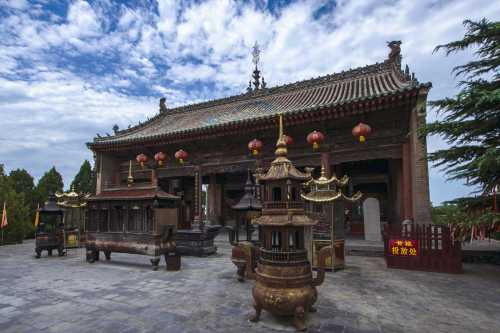Popular Trip Moments
Golden Fairy Tale Village Walking Guide | The Status of the Houtu Temple in Fenyin, Shanxi | Travel routes anywhere | One of Shanxi's Four Famous Towers: Qiufeng Tower|Emperor Wu of Han Once Visited and Composed Poetry Here | Feiyun Tower: A Wooden Marvel Suspended in Time | Nan Song Blue Bridge Rafting | Yuncheng, Shanxi, with over 100 national protected sites, each a treasure. Although the main attractions are in the counties below, the urban area also has some nice places. The urban area of Yuncheng | Shanxi | Qiufeng Tower — A Riverside Masterpiece on the Yellow River | There's a quiet courtyard with a century of history in Shanxi. | A 4-Day Trip to Yuncheng: The Perfect Qingming Getaway | I just came back from a self-driving trip to Linfen Yuncheng, and I just want to say three things. | Dongyue Temple in Wanrong, Shanxi (Yuan Dynasty) | Step into History: Your Ultimate Guide to a 6-Day Romantic Trip to Xi'an, Yuncheng, and Luoyang | The Stunning Feiyun Tower in Wanrong: An Architectural Gem | Wannianrong Feiyun Tower: A Guide to Visiting This Millennia-Old Wooden Marvel
| Wanrong Dongyue Temple | A Stunning Thousand-Year-Old Wooden Building | Wanrong Houtu Temple | Exploring the Ancestral Shrine of China | The Houtu Temple in Shanxi: A Mysterious Journey Through Millennia of History | Hou Tu Temple: A Resplendent Center of Chinese Ancestral Culture | The Wanrong Houtu Temple houses a wooden "Along the River During the Qingming Festival" | Exploring the Wanrong Jiwang Temple, Liang Sicheng's regret | Jiwang Temple|The mysterious temple that Liang Sicheng searched for in vain | Qiufeng Tower is the most beautiful tower I've ever seen. | Enter the Li Family Courtyard and relive the legend of Shanxi merchants | Blue bricks and yellow earth, Shanxi sings and Shaanxi listens. | I didn't realize how much our ancestors left behind until I visited this treasure trove of a place. | One-day Tour of Wanrong, Shanxi | Annual travel review | These 6 places made me redefine shock | National Heritage Site - Wanrong Dongyue Temple | Passing by a Metasequoia forest, Taizhou Huangyan Changtan Reservoir mangrove forest
Recommended Attractions at Popular Destinations
Popular Attractions in Sydney | Popular Attractions in Dubai | Popular Attractions in Paris | Popular Attractions in Shanghai | Popular Attractions in Phuket | Popular Attractions in New York | Popular Attractions in Tokyo | Popular Attractions in Bali | Popular Attractions in Melbourne | Popular Attractions in West Lake | Popular Attractions in Iguazu National Park(Argentina) | Popular Attractions in London | Popular Attractions in Rome | Popular Attractions in Kuala Lumpur | Popular Attractions in Chefchaouene | Popular Attractions in Singapore | Popular Attractions in Kyoto | Popular Attractions in Los Angeles | Popular Attractions in Zanzibar Island | Popular Attractions in Las Vegas | Popular Attractions in Osaka | Popular Attractions in Walt Disney World Resort | Popular Attractions in Beijing | Popular Attractions in Bangkok | Popular Attractions in Barcelona | Popular Attractions in Chengdu | Popular Attractions in Florence | Popular Attractions in Madrid | Popular Attractions in Jungfrau Region | Popular Attractions in Istanbul
Popular Restaurants in Wanrong
李师名吃 | 煎饼食刻 | 李记鱼庄老碗鱼庄承包酒席 | 丑娃饺子(万荣店) | 牛·潮汕牛肉火锅 | 阿利茄汁面(运城万荣店) | 振兴铜火锅(万荣店) | 晋南饭店(万荣店) | 京城一锅羊蝎子 | 蜜雪冰城(易家店) | Mailesihanbaowu | XIANG LI LAI | 白天鹅蛋糕(笑话广场店) | 欢乐牧歌时尚自助(万荣店) | 尚品烘焙(万荣店) | Tianlala (xintiandi) | Xiyuelai Cake (wanrong) | MO MING YUAN MI FEN | 卡西雅烘焙(香江店) | XI AN BO CAI MIAN | XI AN GUAN GUAN MO | LAO SUN FAN ZHUANG | 正新鸡排·炸鸡烧烤(香江广场店) | 小两口户县面(万荣店) | 孙庄牛肉(万荣店) | 鸭小帅(新天地店) | 心和苑炝锅鱼(万荣店) | 嘿爱你寿司(万荣香江店) | 渝家老字号重庆老火锅 | 德克士(万荣店)
Popular Ranked Lists
Top 10 Trending Attractions in Dubai | Popular Trending Attractions in Putian | Top 20 Luxury Hotels near Indian River County | Popular Premium Hotels in Comarca de Avila | Top 20 Must-Visit Restaurants in Shenyang | Top 10 Trending Attractions in Hangzhou | Top 10 Luxury Hotels near Preston | Top 50 Must-Visit Restaurants in Zhuhai | Top 50 Must-Visit Restaurants in Ningbo | Popular Trending Attractions in Toyako | Top 20 Must-Visit Restaurants in Guilin | Popular Trending Attractions in Edinburgh | Top 10 Trending Attractions in Qingdao | Top 10 Trending Attractions in Yangzhou | Popular Trending Attractions in Ejin Banner | Top 10 Premium Hotels near Penzance | Top 10 Local Restaurants in Lushan Global Geopark | Top 20 Must-Visit Restaurants in Nagoya | Top 10 Trending Attractions in Tokyo | Top 50 Luxury Hotels near Chichester | Top 10 Trending Attractions in Sapporo | Popular Premium Hotels in Pandaan | Top 20 Must-Visit Restaurants in Zhoushan | Popular Premium Hotels in Vila do Bispo | Top 50 Must-Visit Restaurants in Foshan | Top 20 Must-Visit Restaurants in Tianjin | Popular Premium Hotels in Opcina Zupa Dubrovacka | Popular Trending Attractions in Yongji | Top 10 Premium Hotels near Baton Rouge | Popular Luxury Hotels Near North Myrtle Beach
About
Payment methods
Our partners
Copyright © 2025 Trip.com Travel Singapore Pte. Ltd. All rights reserved
Site Operator: Trip.com Travel Singapore Pte. Ltd.
Site Operator: Trip.com Travel Singapore Pte. Ltd.









